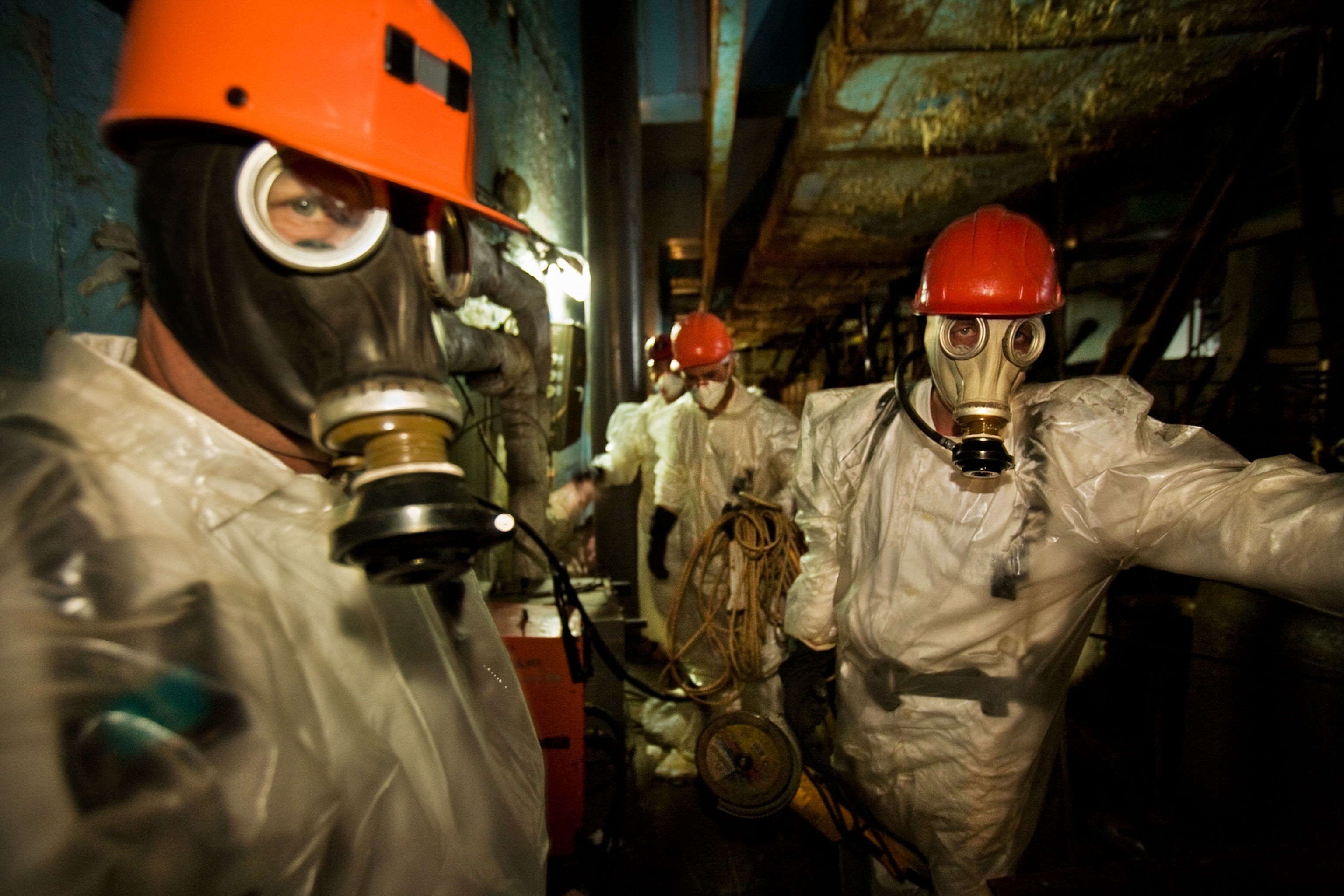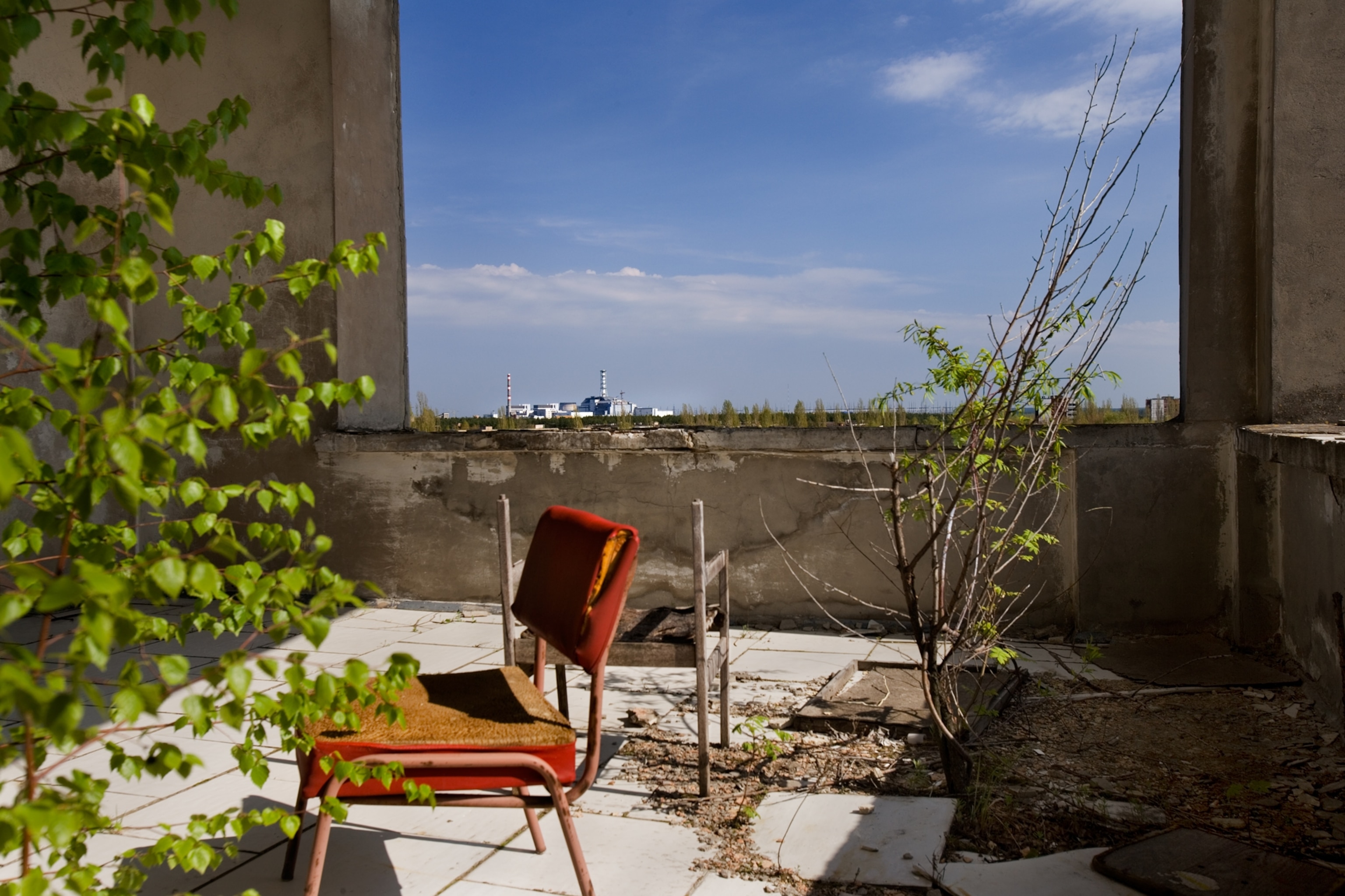










A Long Look at the Effects of the Chernobyl Disaster
Gerd Ludwig's photographs of the aftermath of this catastrophic nuclear meltdown tell a story that continues to unfold.
“Deep inside, at a dark hallway, we stopped in front of a heavy metal door. The engineer indicated I had only a brief moment to shoot. It took him a long minute to open the jammed door. The adrenaline surge was extraordinary. The room was absolutely dark, lit only by our headlamps. Wires were obstructing my view. At the far end of the room I could make out a clock. I was only able to fire off a few frames and wanted to wait for my flash to recharge. But he already pulled me out. I checked my pictures. Out of focus! I begged him to allow me in one more time. He gave me a few more seconds to frame the clock showing 1:23:58 AM—the time when on 26 April, 1986 in the building that housed Energy Block # 4, time stood forever still.” —Gerd Ludwig on photographing inside reactor #4, where an explosion caused a catastrophic nuclear meltdown. Ludwig describes this as one of the most challenging situations he has ever photographed.
When the tsunami caused disastrous damage to Japan’s Fukushima Daiichi nuclear power plant in March 2011, German photographer Gerd Ludwig’s agency, Institute, was contacted by photo editors at Time wanting to assign him for the story. Ludwig was unreachable, at a hotel without internet access at the site of another disaster that happened 25 years before—Chernobyl.
Ludwig has been photographing Chernobyl since 1993 and has returned to the area three times since—in 2005, 2011 and 2013—ultimately venturing deeper inside the reactor than any Western photographer.
“Of all man-made environmental catastrophes in human history, Chernobyl is considered to have caused the most lasting impact. Seeing the full extent of the destruction inside the reactor, and the full force of health consequences—not only in Ukraine but also in neighboring Belarus—is why I felt that I would need to revisit Chernobyl on a regular basis,” he says.
Ludwig is the author of a photography book, the Long Shadow of Chernobyl, documenting his 20-year relationship with what noted scientist Alexei Okeanov calls “a fire that can’t be put out in our lifetimes.” Ludwig recently shared his thoughts with Proof:
Alexa Keefe : What is the most important part of telling this story?
Gerd Ludwig: These images remind us that accidents like Chernobyl are a possible outcome of nuclear power—anytime, anywhere. I want my project to stand as a document of this man-made disaster—to remember the countless victims of Chernobyl, and to warn future generations of the deadly consequences of human hubris.
Alexa: Were there times when you felt in danger?
Gerd: Exposing your body to radiation inside the reactor is only one side of the danger. The other risk comes with radioactive dust specs that can settle easily into soft materials. If ingested they can stay in your body and cause cancer.
After each entry into the reactor I undergo a careful cleaning process: leave the protective gear behind, take a long, hot shower, and change into clean clothes. When I asked a safety specialist to check my equipment after my last visit deep into the reactor, I could read in her face that she thought I was being paranoid. Reluctantly she checked my gear, but then her facial expression completely changed, and she kept repeating again and again “Oh my God! Oh my God! You need to clean your cameras. You need to wash them.”
It turned out that the camera straps were contaminated. I gave my cameras a good cleaning that night, until my Geiger counter indicated that they were fine. And I got new camera straps.
Alexa: You devote one section of your book to the human victims, particularly children born in the years following the disaster. Tell me about your experience photographing them.
Gerd: Much of the nuclear fallout drifted into the Gomel region of Belarus. In 2005, on assignment for National Geographic, I wanted to photograph the children in an orphanage. In one of the orphanages, I photographed 5-year-old Igor. Severely physically and mentally handicapped, he was given up by his parents, and lived at a home which cares for abandoned and orphaned children with disabilities. He caught my attention because most of the time he was sitting motionless, leaning against a wall. With poor eyesight and hearing he was unable to participate even in the slightest interaction with the other children around him. Once in a while his empty eyes wandered in the direction of the other kids in the room, but when they tried to hug him he started crying. Done photographing him I gave his hand a squeeze. The smile with which he reacted nearly brought tears to my eyes.
Alexa: Another group of people you have photographed are those who have returned to the Exclusion Zone to live—whom you have described as preferring to die on contaminated soil than of a broken heart in an anonymous suburb. What was their attitude towards you as someone coming to tell their story?
Gerd: No journalist can move freely in the zone. We have to be accompanied by a guide who works for the administration but we have to pay for their time. Since there are only a few hundred returnees living in the zone today, the guides know most of them. The only vehicles driving in the zone are those controlled by the administration. There is no public transportation and the returnees do not own cars. That is why many returnees enjoy visits by journalists. They are a welcome change into their rather uneventful daily routine. The guides recommend that journalists bring along goods such as fresh bread, cheeses, sweets that the returnees lack, as they rarely get the chance to leave their villages.
Many returnees are very hospitable, offering everything they grow and produce from their own land, from tomatoes to berries, from illegally caught fish to moonshine. Eating food grown on contaminated land makes me sometimes feel uncomfortable. But as a photographer you walk a thin line: you want to be safe but you also need people’s trust and cooperation to get the pictures.
Alexa: The landscape of Chernobyl is changing. Do you see this as a story that will you will continue to tell, or one that you are capturing before it is gone from memory?
Gerd: The reactor may be disappearing from sight under a high-tech dome, the buildings in Pripyat will collapse, the elderly returnees will have passed away, but I am afraid the story of Chernobyl will continue way beyond our lifetime. A scientist in Chernobyl told me, “We could erect fences in certain areas here stating: Not meant for human habitation for 24,000 years to come. And this is only the half-life of plutonium 239.”
The upcoming book though, is a caesura—a pause—but it will not be the end of my coverage. I am curious myself what will be next.
Alexa: What is it about this area of the world that draws you in?
Gerd: My personal relationship with Russia began as I grew up as a child in postwar Germany. My father had been drafted into the Sixth German Army that invaded the Soviet Union in 1942 and fought through southern Russia towards Stalingrad, where the Soviets decimated the German forces. He was lucky enough to be amongst the last soldiers evacuated.
In the darkness of our small refugee room—after WWII my parents had been expelled from their home in Bohemia—I would listen to the sad soothing voice of my father as he conjured images of endless winter landscapes of soldiers battling their way through snowstorms; and people hiding from them in stables and barns. It was not until I grew older that I began to grasp the darkness behind the stories: that the landscapes were stained with blood, the soldiers dying, and the people hiding were Russians filled with fear. My father told these bedtime stories to shed himself of terrible memories of war.
As a young teenager in the mid-1960’s, I was a member of the first postwar generation of Germans. Filled with guilt for my elders’ actions, I compensated by glorifying everything Germany tried to destroy. In particular, I idealized Russia and the communist Soviet system. Finally, Gorbachev’s glasnost—his call for openness in every part of life—confronted me with the social and political realities of a country that had been under totalitarian rule for seven decades.
Alexa: Is there anything else you would like to add?
Gerd: As engaged photographers we often report about human tragedies in the face of disaster, and take our cameras to uncharted areas with the understanding that our explorations are not without personal risk. We do this out of a deep commitment to important stories told on behalf of otherwise voiceless victims. While covering this story, I met many caring and courageous people who allowed me to expose their suffering solely in the hope that tragedies like Chernobyl may be prevented in the future.
Related Topics
You May Also Like
Go Further
Animals
- How can we protect grizzlies from their biggest threat—trains?How can we protect grizzlies from their biggest threat—trains?
- This ‘saber-toothed’ salmon wasn’t quite what we thoughtThis ‘saber-toothed’ salmon wasn’t quite what we thought
- Why this rhino-zebra friendship makes perfect senseWhy this rhino-zebra friendship makes perfect sense
- When did bioluminescence evolve? It’s older than we thought.When did bioluminescence evolve? It’s older than we thought.
- Soy, skim … spider. Are any of these technically milk?Soy, skim … spider. Are any of these technically milk?
Environment
- Are the Great Lakes the key to solving America’s emissions conundrum?Are the Great Lakes the key to solving America’s emissions conundrum?
- The world’s historic sites face climate change. Can Petra lead the way?The world’s historic sites face climate change. Can Petra lead the way?
- This pristine piece of the Amazon shows nature’s resilienceThis pristine piece of the Amazon shows nature’s resilience
- Listen to 30 years of climate change transformed into haunting musicListen to 30 years of climate change transformed into haunting music
History & Culture
- Meet the original members of the tortured poets departmentMeet the original members of the tortured poets department
- Séances at the White House? Why these first ladies turned to the occultSéances at the White House? Why these first ladies turned to the occult
- Gambling is everywhere now. When is that a problem?Gambling is everywhere now. When is that a problem?
- Beauty is pain—at least it was in 17th-century SpainBeauty is pain—at least it was in 17th-century Spain
Science
- Here's how astronomers found one of the rarest phenomenons in spaceHere's how astronomers found one of the rarest phenomenons in space
- Not an extrovert or introvert? There’s a word for that.Not an extrovert or introvert? There’s a word for that.
- NASA has a plan to clean up space junk—but is going green enough?NASA has a plan to clean up space junk—but is going green enough?
- Soy, skim … spider. Are any of these technically milk?Soy, skim … spider. Are any of these technically milk?
Travel
- Dina Macki on Omani cuisine and Zanzibari flavoursDina Macki on Omani cuisine and Zanzibari flavours
- How to see Mexico's Baja California beyond the beachesHow to see Mexico's Baja California beyond the beaches
- Could Mexico's Chepe Express be the ultimate slow rail adventure?Could Mexico's Chepe Express be the ultimate slow rail adventure?







